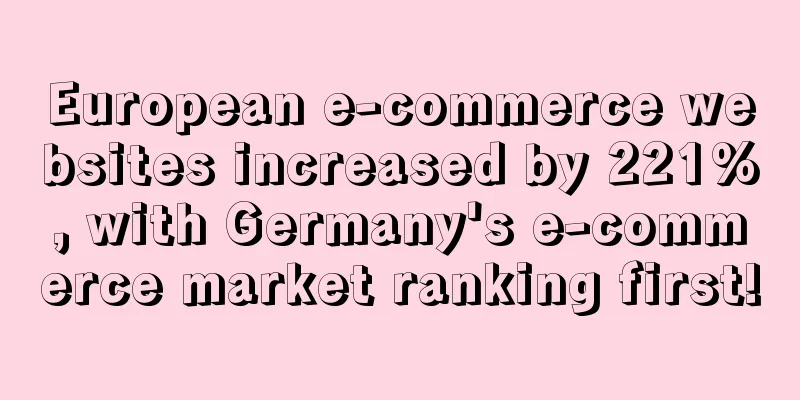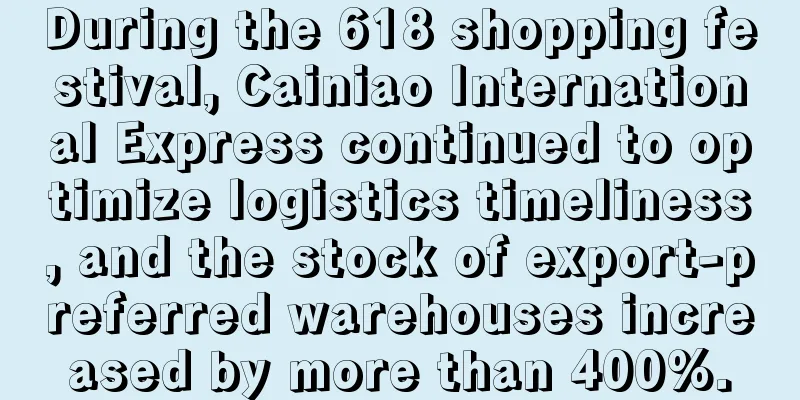European e-commerce websites increased by 221%, with Germany's e-commerce market ranking first!

|
According to the latest public data, the number of European e-commerce websites increased by 126% in 2022. Compared with the data in 2019 before the epidemic, the number of e-commerce websites increased by 221%. It is currently the leader in the creation of e-commerce websites in the world, and the number of e-commerce websites in the world has increased by 42%.
There are 44 countries and regions in Europe with a population of about 750 million. According to data released by Postnord, the number of online shopping by European consumers reached 297 million in 2021, and according to the estimated data provided by the surveyed consumers, the amount of online spending by European consumers in 2021 reached 465 billion euros.
The global blockade over the past two years has given a strong impetus to global e-commerce sales. According to the "2021 European E-commerce Market Research Report" released by European payment giant Nexi, in terms of market size, the top three largest European e-commerce markets are Germany, Italy, and France. In 2021, Germany's e-commerce sales reached 190 billion euros, an increase of 18% year-on-year; while Italy and France's e-commerce sales in 2021 reached 186.7 billion euros and 123.4 billion euros, respectively.
In addition, Nexi data also shows that the Netherlands, Ireland and Austria are all countries with great potential for e-commerce in Europe. 87% of consumers in the Netherlands frequently shop online, and 81% of consumers in Luxembourg frequently shop online. Among all European countries, Austria and Germany have the most cross-border business, with the proportion of cross-border shipments by sellers being 18% and 11% respectively.
According to the "European E-Commerce Report 2021" released by Ecommerce Europe, the proportion of European e-commerce revenue to GDP has gradually increased from 3.11% to 4.6% from 2017 to 2021. The contribution of European e-commerce to GDP cannot be underestimated.
In the period of rapid development of the cross-border e-commerce industry, Europe, as one of the largest and most developed regions for e-commerce and currently also the fastest growing region for e-commerce websites in the world, has naturally become the first choice for many companies to deploy their businesses. In different European countries, the most popular products and online shopping platforms vary among consumers.
Lengow's "2022 European E-commerce Market Trends Review" report shows: In Germany, more consumers are beginning to turn their attention to high-quality products and platforms from Germany; In France, consumer acceptance of digital payments and speed of online shopping will reach new highs in 2022; In Belgium, most English speakers living in the country prefer to shop online on German e-commerce platforms; In the Netherlands, the local website Bol.com is the most visited e-commerce platform in the market; In the UK, more than 57% of British consumers will choose to shop online through e-commerce platforms in 2021, and 25% of the country's total online consumption is completed through Amazon; Poland, Allegro has always been the e-commerce leader in the Polish market; Italy, in 2021 more than 50% of Italians purchased from international websites such as Amazon, eBay, and Aliexpress due to a lack of local purchasing options; Norwegian consumers have a strong interest in shopping on cross-border platforms, with Zalando, Wish and eBay ranking the top three.
From the perspective of the reasons why European consumers shop online, Nexi data shows that the three main reasons are convenience, low prices, and a wider range of product categories. The main reason why consumers give up online shopping is that the shipping price is not displayed until the last step of payment. The high shipping price is not displayed transparently enough, which loses one-third of potential consumers. Europe E-commerce website |
<<: Amazon experienced the largest-scale layoffs, with a reduction of 99,000 employees!
Recommend
Australian small business e-commerce revenue exceeds physical store revenue
New research shows e-commerce revenue has surpass...
What is Yunshu Seller Data Service? Yunshu Seller Data Service Review, Features
Yunsu Seller Data Service (Shanghai Yunsu Informa...
Driven by the epidemic, demand for skin care products in North America has increased
According to a survey of more than 10,000 users i...
Online revenue in the Netherlands grew by more than 68% in March
Foreign media reported that online revenue in the...
SHEIN sellers in the era: catching up, innovating, and breaking out in the wave of going overseas
For Chen Qiao, who seized the overseas business o...
What is Yingcang Logistics Technology? Yingcang Logistics Technology Review, Features
LINKW Technology was founded in 2018 and is headqu...
What is Stance? Stance Review, Features
Founded in 2009 and headquartered in California, ...
Crazy sales of 8 billion! Shanghai's big sellers made a fortune in the niche market
Every spring, the demand for gardening tools and ...
What is Big Bear Intellectual Property? Big Bear Intellectual Property Review, Features
Daxiong Intellectual Property is an international...
Dunhuang.com releases new policy to update sellers' backend product editing function
Recently, Dunhuang.com issued an announcement sta...
What is Tophatter? Tophatter Review, Features
Tophatter is a cross-border e-commerce platform o...
What is Homage? Homage Review, Features
Homage is a sportswear mall. About Homage Homage f...
What is CosmoPay? CosmoPay Review, Features
CosmoPay is a cutting-edge European payment gatew...
10club raises $40 million in seed funding as Indian e-commerce aggregation business heats up
According to the Times of India, Indian e-commerc...
What is Karmaloop? Karmaloop Review, Features
Karmaloop is a famous American fashion online stor...









